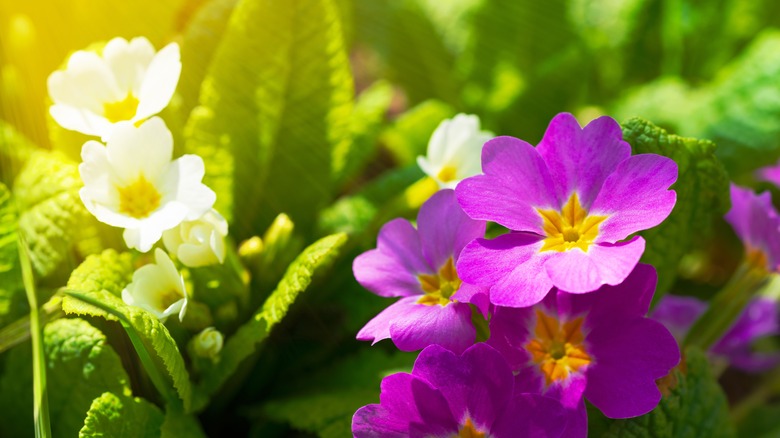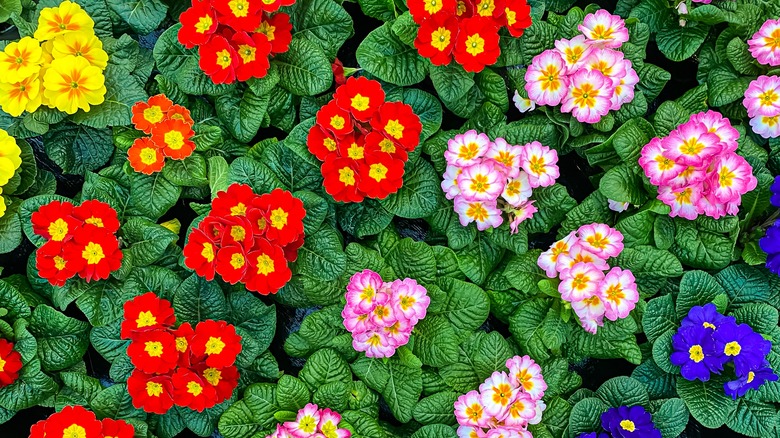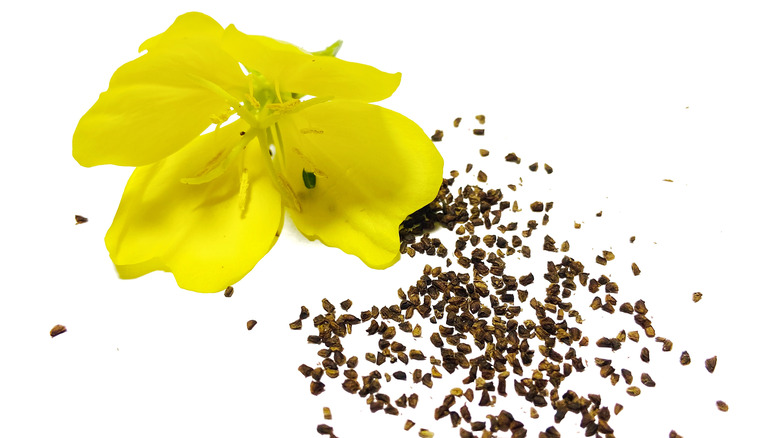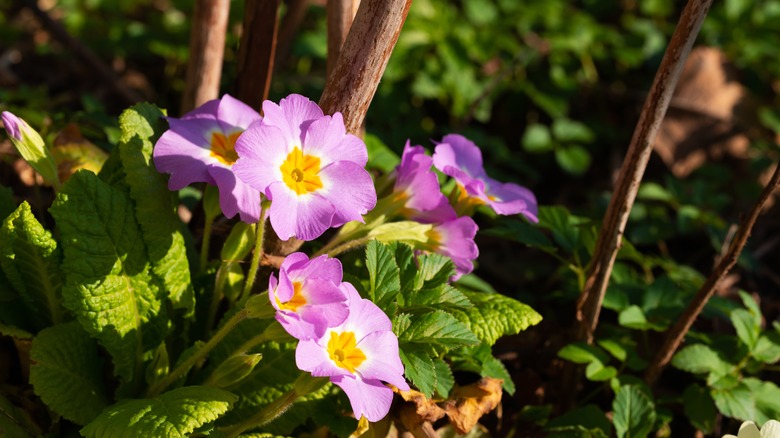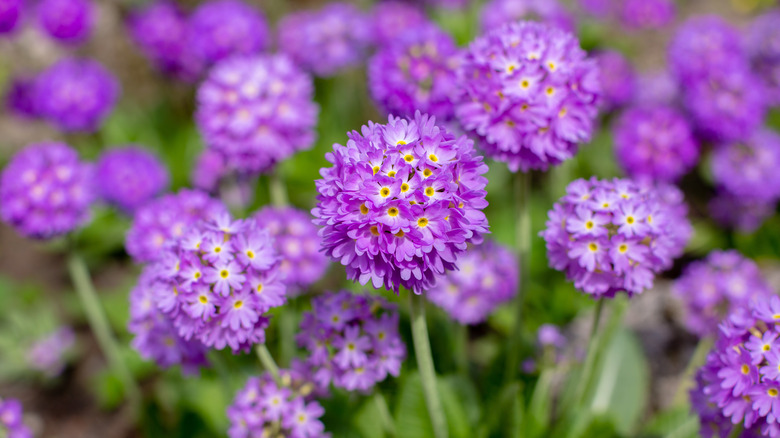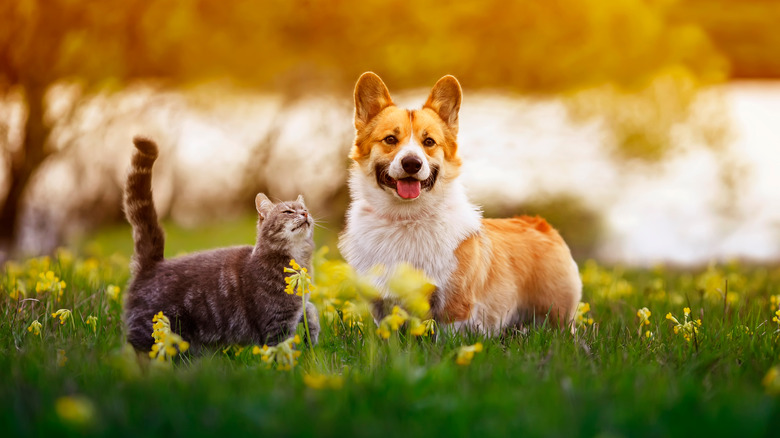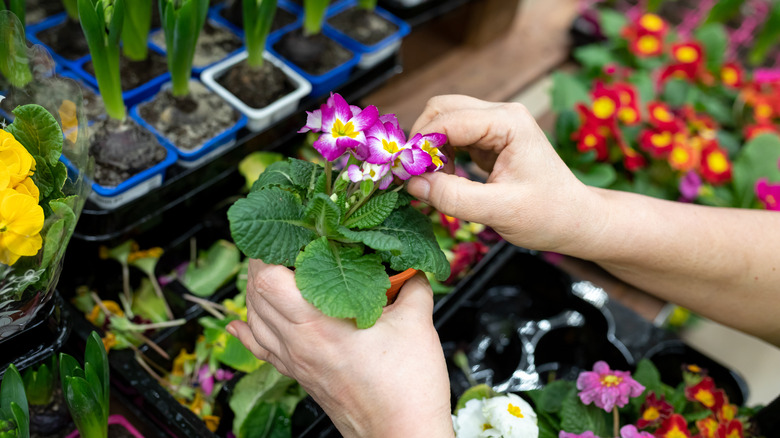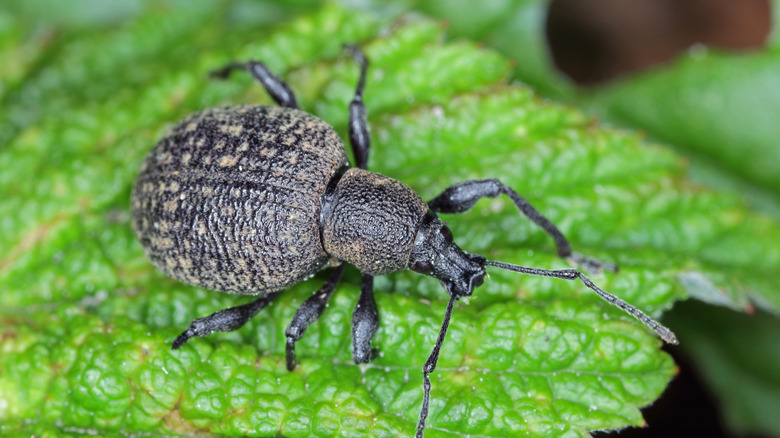How To Grow And Care For Primrose Plants
Primrose plants, also known as Primula vulgaris, are small, fragranced, flowering plants that light up with a variety of colors during their spring and summer-blooming seasons. Britannica states that primrose plants tend to grow very close to the ground, spanning around 6 to 20 inches tall as mature plants, although some only reach 2 inches tall. Their foliage forms in circular patterns and usually grows in groups with other primrose plants. The flowers that rise above the foliage come in colors ranging from white to blue, including red, pink, orange, and purple, per Gardening Know How.
Harvesting History mentions that the primrose flowers first emerged in North America, in the cool mountain areas. When settlers discovered the adorable plant, they brought them back to Europe, where they were commonly grown in cottage gardens. These flowers are still widely used to decorate gardens today and are relatively easy to grow and maintain. If you think primrose plants will make the perfect, colorful addition to your garden, this guide will give you all the information you need to grow and care for these plants.
How to use in garden
Primrose plants grow with an abundance of colors, including white, red, pink, orange, purple, and blue, per Gardening Know How. These colors can easily brighten up a garden or yard in a variety of ways. They can be placed in flowerbeds with an abundance of other flowers that share the same or a rainbow of different colors. They can also be placed among plain colored plants, like evergreen trees, to add texture and color to that area.
Primrose plants also grow beautifully in potted environments, as well. They can light up your balcony or porch with many bright colors and even spread their sweet-smelling fragrance throughout the area. In pots, they are also great for lining flowerbeds, walkways, or even the entrance to your home. Similarly, the flowers will grow beautifully in a window box to further decorate your home. Indoor houseplant collectors can also benefit from the plant's beautiful flowers that can bloom easily and abundantly within your home.
How to grow a primrose plant
Fine Gardening states that primrose seeds are best planted between January and March, which allows them to germinate naturally as the weather transitions from winter to spring. To plant the seeds, start by filling a small pot with a seed-starting mixture. Once the pot is filled, scatter the seeds over the surface and lightly cover the seeds with vermiculite.
Start the germination process by placing the pot in a protected outside position so the seeds can be exposed to the environment where they will grow. Fine Gardening states that placing the pot against a north-facing wall of a building usually provides the best protection. For even more protection, you can also place an old window screen over the pot. Between March and April, the seeds should begin to germinate. When the seeds have sprouted, place their pot in a shallow tray of water until their soil is damp. As the plants continue to grow, never let their soil run dry. When the young plants start developing true leaves, they are ready to be transplanted either into your garden or a more permanent potted location.
How to care for primrose plant
Primrose plants are known for being somewhat hardy and adaptable plants, as mentioned by Gardening Know How. This means they are not difficult to keep alive, and they adjust easily to new environments. The Spruce shares several tips on how to help you get the most out of your primrose plants and help them thrive for longer periods of time.
Before locating a spot to plant your primroses, ensure the position in which you will place them is only a partial sun position. These plants thrive in a somewhat darker and cooler environment, which they can receive in the shaded parts of your garden. Depending on the variety of primrose you have, the plant may prefer more or less shade, but all primrose plants need to receive at least a portion of shade to thrive.
Likewise, water is also very important for the health of your primroses. These plants love water; therefore, ensure their soil is watered regularly and remains moist. Mulch can be added over the plants' soil to help them retain moisture.
Fertilizer can also be regularly used to strengthen your primroses and help the plant flower more abundantly for longer periods of time. The best fertilizer for these plants is a half-strength liquid fertilizer used in the spring while the plant is flowering.
Primrose plant varieties
Primrose varieties are abundant, according to Gardenia, who states that there are over 400 different types of primrose plants. Each variety has its own unique shape, size, and color. Let's take a closer look at a few of these many primrose varieties.
- Giant Cowslip (Primula florindae): These plants are favored by gardeners everywhere due to their beautiful fragrance and ease and abundance of growth.
- Round-Headed Himalayan Primrose (Primula capitata): This variety is known for its beautiful purple flowers that bloom from spring to early fall and are commonly used in flower arrangements.
- Siler-Edged Primrose (Primula marginata): The blooms of this variety are beautiful purple-blue flowers with a white circle near the center of the plant, which grow perfectly in a tough, rocky environment.
- Siebold Primrose (Primula siebold): Commonly found on the forest floor, this variety blooms magnificent pink flowers from late spring to early summer.
- Orchid Primrose (Primula vialii): This unique shaped flower looks like a cone with a red tip and small purple flowers surrounding the cone like a skirt at the bottom.
- Drumstick Primula (Primula denticulata): Drumstick Primula have a round crown of flowers that are bunched together in the shape of a sphere.
- Allioni's Primrose (Primula allioni): Blooming between winter and spring with little purple flowers, this variety grows beautifully in containers or a rocky environment.
Are primrose plants toxic?
NC State Extension states primroses are a relatively toxic plant. For humans, the toxicity has more of an external effect that acts similar to an allergen. The toxic substance is located on the leaves, which can cause a reaction when touched by bare skin. This reaction can range from a bit of irritation to the formation of blisters on your skin. To protect yourself from the somewhat irritating effects of this plant, it is advised to wear gloves when needing to handle the plant in a garden or potted setting.
It is also recommended to keep your primroses away from household pets. Although Wag! claims that many veterinarians think primroses are safe to have around pets, the consumption of the plant can have some uncomfortable effects. For dogs specifically, consuming a primrose plant can lead to vomiting, indigestion, and irritation of the skin and eyes. If you worry about the symptoms your pet is showing, seek professional help for the health and safety of your household pets.
How to repot a primrose plant
SFGATE explains that when it's time to find a new container for your potted primrose, the diameter of the new pot must be at least 1 to 2 inches larger than the diameter of the current pot. How tight the plant's root ball is once you remove it from its current pot will determine if the new pot needs to be larger. The new pot must be sterilized appropriately to ensure no pests or diseases are lingering in the pot. This can easily be done with a diluted bleach solution.
To prepare the new pot, line the bottom of the pot with small pebbles to better help the plant drain water, then add another layer of well-draining potting soil on top of the pebbles. When placing the primrose into the new pot, ensure the plant is centered and at the same depth as its previous environment. Fresh soil should be placed around the plants to fill in the gaps and hold the plant steady, but do not place soil above the root ball because this action changes the depth of the plant. Finish off by thoroughly watering your freshly potted primrose and placing it in a fully shaded position as it recovers and adjusts to its new container.
Common pests for primrose plant
Even if you take increasingly good care of your primroses, they are still susceptible to common pests that roam through your garden or amongst your houseplants at home. Gardening Know How mentions that one of the most common and dangerous pests that can affect your primroses is the vine weevil. These pests can destroy your plants by feeding on their roots below the surface. They work undetected within the dirt until your plant suddenly falls to the ground and dies.
To rid your garden and plants of this pest, you must remove all the plants and soil that is infested with them. Dispose of these elements properly in the garbage. Never place pest-infested plants or soil in the compost where it can easily grow and continue infesting and killing surrounding plants. Then, you can use gravel amongst the infested area to cease the reproduction of the pests that may remain within the area, eventually dying them out. Chemical treatments are also available for extreme cases.
